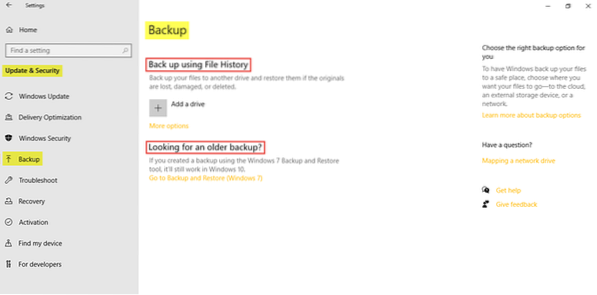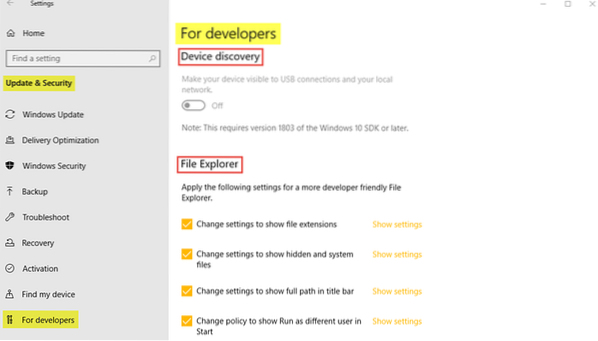Looking for Windows Updates on your Windows 10 PC? Go to the Windows 10 Settings app to find the latest Windows Update and install them on your PC. In this post, we will have a look at the Windows Update and Security Settings in Windows 10 and learn how to change and update them on your PC.
Windows Update & Security Settings in Windows 10
To open the Windows Update and Security Settings on your Windows 10 PC, go to the Start menu > Settings app > Windows Settings > Update & Security. The Windows Update and Security section will open and you will see the following categories or tabs in the left pane.
- Windows Update
- Delivery Optimization
- Windows Security
- Backup
- Troubleshoot
- Recovery
- Activation
- Find my device
- For developers
Continue reading to know more about all these categories of settings.
1. Windows Update

The Windows Update tab will show you the current status of your PC, whether it is updated or not. Your device will show all the latest pending updates and the status of their updates. As we can see in the image, there are two updates with the status of 'pending restart' and 'pending download', which requires a restart. You can either choose the option to 'Restart now' or 'Schedule the restart'. These updates usually come with new advanced features and new improved security features.
You will be also able to view your Windows 10 Update History. You will further see more options to pause updates for 7 days or more and change active hours. Click on 'View update history' to get a glimpse on feature updates, quality updates, driver updates, definition updates, and other such updates. You can also uninstall updates and check for recovery options.
Advanced options include update options and update notifications where you can turn on/off the settings for the following.
- Receive updates for other Microsoft products when you update Windows
- Download updates over metered connections
- Restart the device as soon as possible when a restart is required to install an update
- Show a notification when your PC requires a restart to finish updating
You will also find links to pause updates, delivery optimization, and privacy settings.
Furthermore, in the Windows Update tab, under Related links, you will see the options such as Check Storage and OS build info.
Windows Update will work differently in Windows 10. There will be no Patch Tuesdays. Microsoft has said it will use two different methods to provide updates: regular updates to normal users and periodic updates to users operating mission-critical operations. Consumers will be delivered the updates and new features as soon as they are available. Businesses will be able to opt-in to the fast-moving consumer pace, or lock-down mission-critical environments, to receive only security and critical updates to their systems.
TIPS:
- You can use Quiet Hours to schedule restarts.
- You can now log in automatically after Windows Update if you enable the Use my sign in info to automatically finish setting up my device after an update setting.
2. Delivery Optimization

In the Delivery Optimization tab, you can allow downloads from other PCs. By turning it on, your PC may send parts of previously downloaded Windows updates and apps to PCs on your local network or on the Internet.
You can also download Windows Updates & Apps from other Windows 10 PCs. When this option is turned ON, your PC may also send parts of previously downloaded Windows Updates and apps to PCs on your local network or PCs on the internet, depending on what's selected from the provided options.
Advanced options include settings where the users can limit how much bandwidth is used for downloading or uploading updates, monthly upload limit, and such. Activity monitor will show the download statistics and upload statistics.
See this post if you wish to learn about a workaround to Turn Off Windows Update in Windows 10. You can also make Windows 10 notify you before downloading Updates. This post shows how to run Windows Updates from Command-Line.
3. Windows Security

In the Windows Security tab, you will find settings that will help to keep your PC safe and secure. Click on 'Open Windows Security' to take a glance at the various protected areas and see if there are any actions needed. The various protection areas are mentioned below.
- Virus & threat protection
- Account protection
- Firewall & network protection
- App & browser control
- Device security
- Device performance & health
- Family options
This section lets you configure Windows Defender settings and lets you turn on real-time protection, cloud-based protection, and sample submission. Scroll down and click on Use Windows Defender to check if your PC is well protected or not.
Read: Windows 10 Security features.
4. Backup

Sometimes, the original files can get deleted or lost accidentally. In such a situation, it is necessary to have a backup of the files. You can click on 'Add a drive' to create a backup using file history. You can choose an appropriate place for Windows to backup your files such as an external storage device, the cloud, or a network.
5. Troubleshoot

Running the troubleshooter might help your device keep functioning properly.

To view your recommended troubleshooter history, click on the 'View history' link. Recommended troubleshooting settings will take you to the Diagnostics & feedback settings where you select the feedback frequency and recommended troubleshooting options.

Further below, you will see various options where you can run the troubleshooter to find and fix problems.
- Internet connections
- Playing audio
- Printer
- Windows update
- Bluetooth
- Incoming connections
- Keyboard
- Network adapter
- Power
- Program compatibility troubleshooter
- Recording audio
- Search and indexing
- Shared folders
- Speech
- Video playback
- Windows store apps
All you have to do is select the option and click on the 'Run the troubleshooter'.
6. Recovery

In this tab, you will find the option to reinstall Windows in case your PC is giving you problems. It is also possible to go back to the previous version of Windows 10 on your PC within a span of 10 days or so. Advanced startup will enable you to restore Windows from a system image, change Windows Startup settings, and so on.

You can explore and learn more about the recovery options.
If by any chance you don't like the updated Windows 10 OS, you can roll back to your previous build of Windows from here using a system image or a removable drive. The recovery option also gives you a chance to Reset your PC where you can reinstall Windows in your PC while keeping your files safe.
7. Activation

Here, you will find details of the Windows edition and activation. Users can go to the store to upgrade your version of Windows and change the product key.
8. Find my device

This is a feature that can help you locate any of your Windows 10 device such as a PC, laptop, Surface, or a Surface Pen when it is lost or stolen. To use this feature, the location should be turned on. You have to sign in to your device with a Microsoft account and be sure you are an administrator on it. This is not applicable to a work or school account, iOS devices, Android devices, or Xbox consoles.
- On the device that you want to change, select Start > Settings > Update & Security > Find my device.
- Select Change for the device you want to change.
You can lock your device remotely when you find it on the map by selecting Lock > Next. Once the device is locked, you can reset your password for added security.
9. For developers

As the name suggests, this tab includes settings only for developers and is linked to the official Microsoft website where developers can enable their device for development, and sideload apps.

You have to sign in as an administrator in order to make changes to these settings.

These settings are to be used for development purposes only.
We have, thus, covered all about the Windows Update and Security Settings in Windows 10.
I hope this was a useful read!

 Phenquestions
Phenquestions


